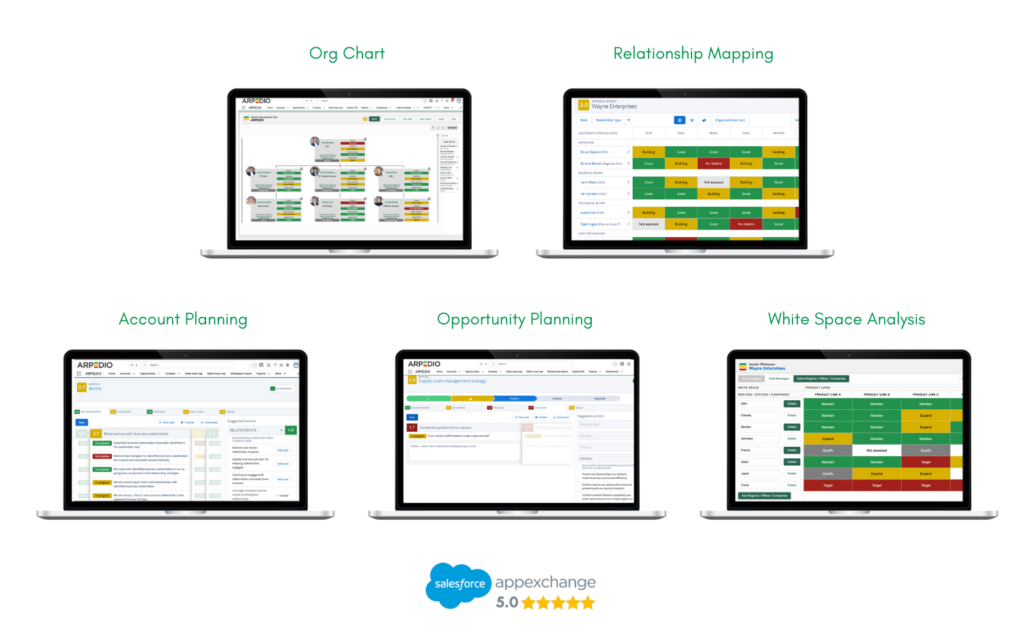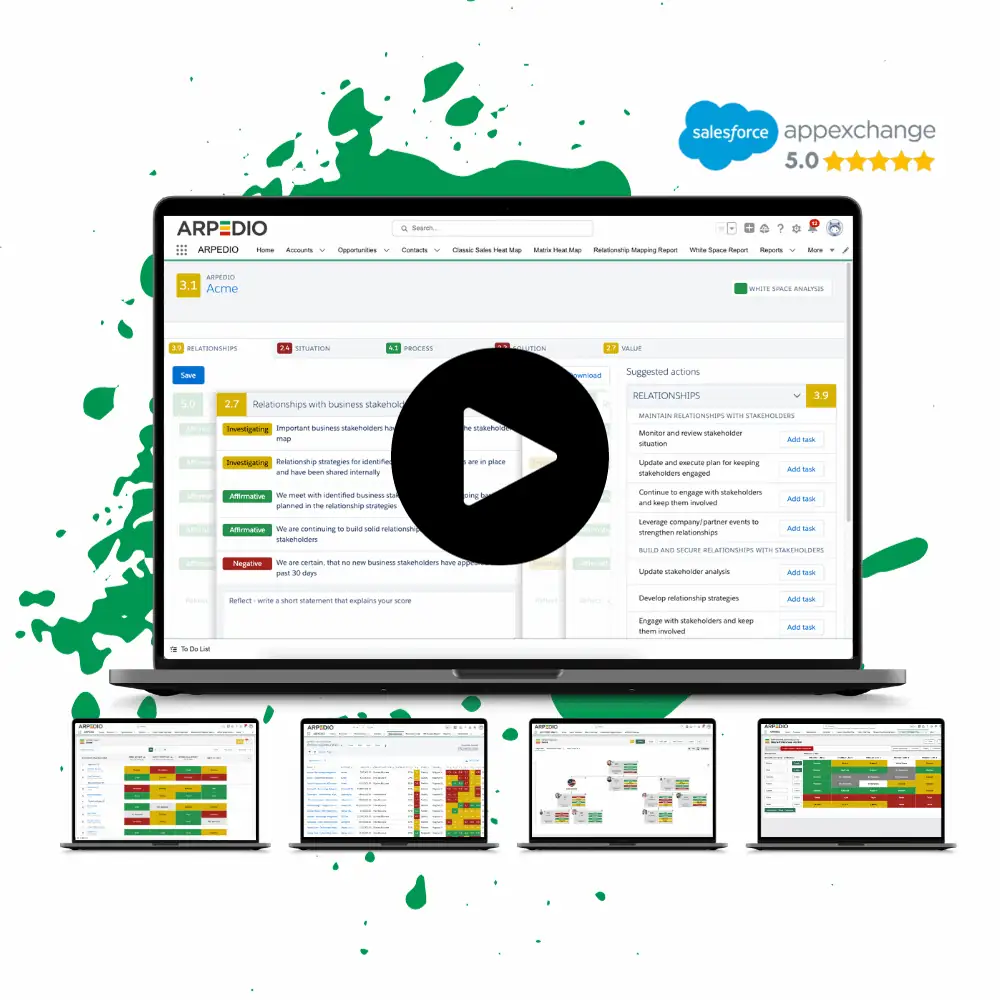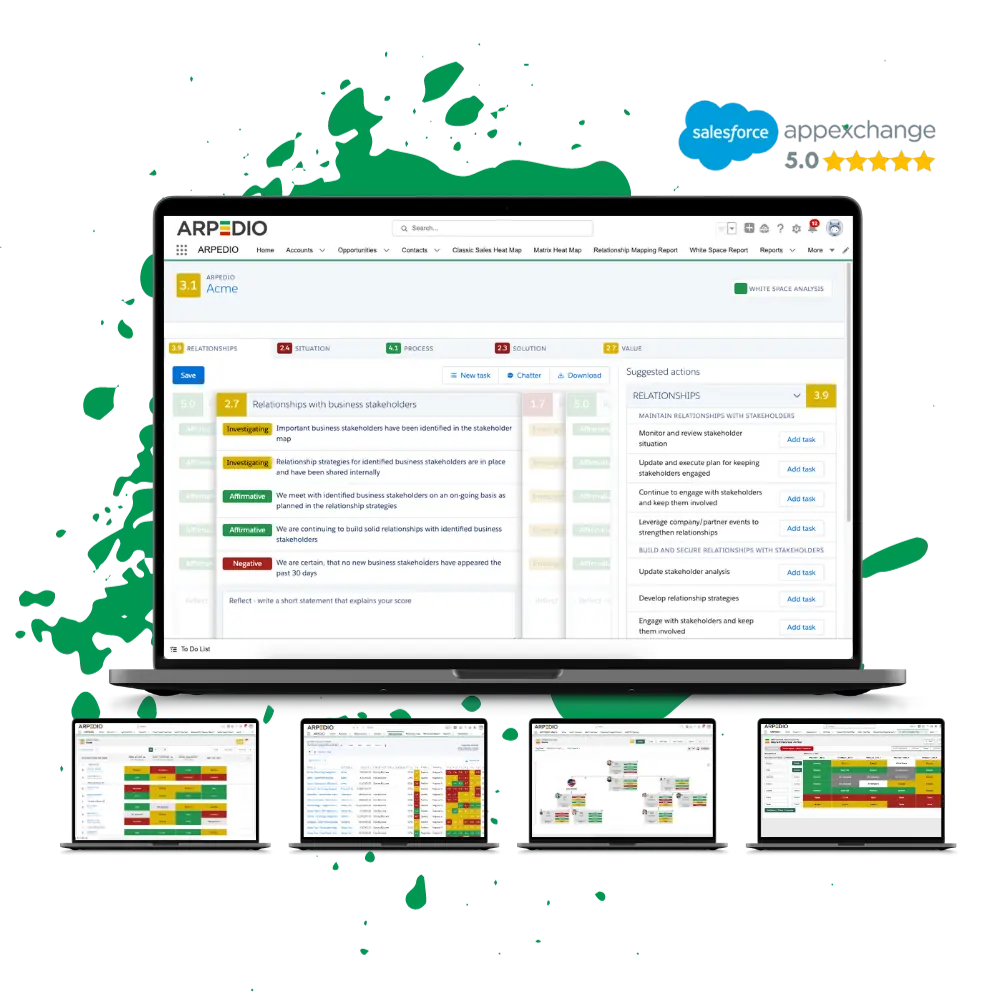Account-Based Selling is a targeted approach to B2B sales. It requires investing your team’s resources to target multiple stakeholders within an account. Instead of the conventional one-to-one sales approach, each account is treated as a market of one. To be successful with an account based approach to sales, collaboration is key. Marketing and Sales need to be aligned and working closely together.
Table of Contents
The continuous technological innovations are changing the way we do sales. After decades of approaching sales based on gut-feeling and wishful thinking, we’ve recently entered an entirely new – and very exciting – era. An era where sales and strategic account management are driven by intelligent, targeted prospecting in close collaboration with marketing. Thanks to Account Based Marketing (ABM), the messaging throughout the customer journey is personalized, and as account-based selling technology has rapidly evolved in both maturity and complexity, it ensures that your sales approach is backed by actual data. It’s the era of account-based selling.
Using an intelligent sales enablement strategy like account-based selling now allows companies to easily identify the most viable accounts based on a broad range of criteria, and tailor sales and marketing strategies to meet each account’s individual needs. This way, every account is treated like its own market, and sales and marketing work together and put a lot of effort into turning prospects into customers.
In the following, we’ll deep dive into account-based selling: what it is, how to be successful with it, and how adopting account-based selling can benefit your business.
What is Account-Based Selling?
In short, Account-Based Selling is a targeted B2B sales methodology or strategy that entails heavy investing into targeting multiple stakeholders within an account opposed to the conventional one-to-one sales model. It’s very similar to Account based marketing that also targets accounts and treats these as a market of one rather than focusing on individual leads. This strategic and very targeted sales prospecting model is primarily used within complex B2B sales, and has a full on customer-centric approach with focus on obtaining high-value engagement.
It’s a prerequisite for Account-Based Selling that a company come together as a unified entity. A strong collaboration between sales and marketing is inevitable, but also customer success, product development and finance, let alone the executive team, need to align and work alongside one another to deliver a tightly integrated experience across all business units during the whole decision buying journey – even after the sale is made. Thus, to succeed with Account-Based Selling, all departments must work together towards shared goals and have the same idea of what the ideal customer profile is.
How do you support an Account-Based Selling Approach?
Your company as a whole needs to support the account-based selling methodology for it to be successful. Most importantly, it’s inevitable to engage with multiple stakeholders, to collaborate across (all) departments, as well as staying customer-centric throughout the process. We’ll elaborate below.
Engage with multiple stakeholders
First and foremost, your entire sales process must be completely tailored to your targeted accounts, and secondly, when you identify the good-fit targets, you must ensure to engage with numerous stakeholders at once.
A single stakeholder’s individual behavioral data doesn’t necessarily say a whole lot about the company as a whole’s readiness to invest in your solution(s) – even less, if the stakeholder isn’t one of the important decision makers. That’s why it’s so important to target and start conversations with multiple stakeholders within a prospective account. The more stakeholders you reach out to, the more likely it is that (at least) some of them will start engaging with you and your organization.
Another important reason not to put all your money in one pot, is to make you much less dependent on a single stakeholder. When you involve a larger number of decision makers in the purchasing decision, you minimize the risk of a deal stalling or falling through if that one stakeholder gets a new job, goes on leave, or gets sick.
Cross-department collaboration
First, we saw the introduction of ABM, and now account-based selling is on everyone’s lips. What they have in common is their account based approach, and how this can only be successful through cross-department collaboration.
That’s why we can’t stress this enough: Account-based selling requires company-wide buy-in and collaboration. So, instead of sales going after one or few individuals within a prospective account, the entire team should be dedicated to pursue numerous stakeholders at the target company with messaging that is highly personalized. This is where the collaboration and alignment between sales and marketing becomes crucial. Marketing needs to support sales in creating tailored content for these target accounts for this account-based selling strategy to work.
Customer-centric in all aspects
Don’t focus on what you have, i.e., what you’re trying to sell. You should first and foremost worry about what your customer needs. Only when you fully understand the pain points your customer has, will you be able to help solve them. And it should always be in this order.
Traditional sales and marketing was more focused on the products/services and ‘forcing’ these on the customers. But, the tables have turned. And now we must start with the customers, and adjust our offerings to fit their specific needs. That’s how we build the best possible foundation for our sales teams to increase their hit-rate when following the account-based selling methodology. And this is also why it’s crucial that the product development team is involved as well. They should take part in the process and familiarize themselves with customer pain points, in order to always take prospect and customer feedback into account when planning and developing new features, turning products into an indisputable fit for every customer.
How can Account-Based Selling benefit your business?
Let’s jump right into the most significant benefits of Account-based selling. We’ve already established that the account based approach requires a great deal of effort and resources into your key accounts. Therefore, you can’t afford to target the wrong customers, let alone hit them with the wrong messaging. Once you got this all figured out, there are great benefits to reap from the account-based selling approach. But, it’s not a walk in the park. If you want to see results, you have to carefully research your prospects and plan accordingly.
Why you need to invest in account-based selling
1. Increase engagement with key decision makers
Account-based selling is the most effective way to increase engagement with key stakeholders on your target list.
2. Build trust with decision-makers
Today, people don’t buy from companies, they buy from people. With multiple touch-points into an account as well as tailored messaging, you signal that you genuinely care about your customer’s success.
3. Increase ROI on your sales campaigns
Studies show that account-based selling campaigns outperform other marketing investments. Incorporating email marketing in your account-based selling approach is one of the most straightforward and effective tactics you can use.
4. Increase customer lifetime value
Every single customer is obviously important when you’re running a business – whether it’s the newly acquired one or the one that’s stuck with you for years. However, even though you should of course treat every customer as the most valuable, there’s no denying that some customers are objectively worth more to your business than others. This type of customer makes a significant impact on a company’s bottom line. They are the most likely to make recurring purchases, their loyalty and advocacy can attract new customers and can even influence how other people perceive your brand. Needless to say, this type of customer also has an extraordinary customer lifetime value (CLV).
5. Increases internal collaboration and alignment
Adopting an account based strategy aligns the efforts of the whole revenue department, and ensures that everyone is on the same page.
All in all, adopting the Account based sales model has the potential to pull down sales barriers, increase the deal size, shorten the sales cycles, help your team hit quota and close more deals, and thus provide greater ROI. So, what are you waiting for?
The complete Account-Based Selling platform
The Complete Account-Based Selling Platform
Want to make the most of your Salesforce setup? Empower your sales professionals with the capabilities of ARPEDIO’s Account-Based Selling platform.
How to Implement Account-Based Selling
Now that you’re familiar with the many advantages of account based selling, let’s look into how to actually implement it in your organization.
As you might have guessed, it’s not a quick fix: It requires testing and execution on a smaller scale to see what works and what your impact can potentially be. That’s why we suggest you make the shift to account-based selling in stages rather than going all in at once. You want to take the leap one baby step at a time. A fitting phrase to keep in mind when you start your account-based selling implementation is ‘you must walk before you can run’.
Start by engaging–let’s say–25% of the organization in cross-functional teams, and then once they start seeing some traction, slowly start increasing this number until you eventually hit 100%. Implementing a full-on account-based strategy in your organization typically takes between 12-24 months. However, if your Sales and Marketing teams are already working in strong alignment as you set out on your account-based selling adventure, the transition time will undoubtedly be shorter, and (thus) you’ll start seeing the results of your new account-based selling approach much sooner.
Do keep in mind that implementing account-based selling doesn’t come without a ton of preparation and collaboration across the entire organization. But don’t lose hope if you take a swing and miss a couple of times along the way – that’s inevitable when you take on a new strategy. As soon as account-based selling takes a hold in your organization and you start outperforming your sales plans, forecasts and targets, we bet you’ll ask yourself why you didn’t embark on this journey years ago.
4 Steps to get Started With Account-Based Selling
1. Define your ideal customer profile (ICP)
The whole point of account-based selling is focusing your time, energy and resources on a limited number of accounts. Therefore, it’s essential to be very selective with those accounts. Essentially, what you’re doing is putting all of your eggs in just a few baskets, so you can’t afford to target the wrong companies. If you do, this will have a significant impact on your revenue – and not in a good way. Another way to think of it is this: Every time your team’s resources are spent on targeting a poor fit, you’ll be missing out on a potential great match. For this reason, defining your ideal customer profile is alpha omega in account-based sales, as it allows you to spend your time on the customers and prospects that are most likely to buy from you.
2. Define your buyer personas
When you’re all set on the accounts you want to target, then it’s time to establish the essential stakeholders within those accounts. According to Gartner, an average of 11 individual stakeholders are involved in a B2B purchase – and that number can sometimes flex up to nearly 20. We can all agree that’s a lot of different stakeholders to cater to, nonetheless, it’s absolutely crucial to connect to every single one, if your ambition is to win the account.
One way to go about this is to review your past 20-50 closed-won deals (depending on the size of your company) and hold these up against your defined ICP: Which stakeholders did you engage with, and which of these had the biggest say? Then review the same amount of closed-lost deals and identify the relationships you didn’t manage to establish – for instance, are there a specific type of stakeholders you failed to connect with, or did you spend time on relationships that didn’t influence the final decision. This exercise will help you outline the key stakeholders within each of your target accounts.
3. Develop your outreach strategy
The account-based sales strategy is 100% dependent on tailored content: As you target various buyer personas, the story you tell must be unique and customized to those different personas. Client facing sales professionals and marketers need to work closely together to establish the most effective and valuable content for each account and buyer persona.
Additionally, never lose sight of the customer buying journey. The customer journey isn’t what it used to be: it’s unpredictable as potential customers zigzag on their way to purchase. Therefore, it’s also crucial to tailor your content and offerings to each stage of the (complex) sales process.
4. Create your target account list
Now that you’re all set on the specific accounts you want to go after, you’ve pinpointed the stakeholders you need to engage with within those accounts, and planned your outreach strategy accordingly, then it’s time to build your target account list. This list should include both existing customers as well as promising new ones.
People who know a thing or two about account-based selling suggest that you build your target account list with different tiers. Depending on the size of the tier, your team’s efforts and the level of personalization should be allocated accordingly: The smallest tier (20-50 accounts) receives the most resources and attention, whereas the bigger tier (around 200 accounts) receives less.
Outreach to the first (and smaller) tier is based on thorough research and is fully customized. And both Marketing, Sales and Management are largely involved in securing this business. The second (and bigger) tier are targeted based on their industry and persona. SDR’s will typically take the lead on this tier, engaging prospects via phone, email and social media, while Marketing works their magic with advertising and events. Ideally, it’s a multitouch campaign that spans several weeks.
In conclusion, the solutions you present should be a result of broad collaboration across your business and in co-creation with your customers. Ongoing feedback from customers is the only way to continuously provide value.
Account-Based Selling – yay or nay?
Not sure if account-based selling for you? You might be right. The account-based selling model isn’t for everyone. It will often depend on what you sell, your average deal size, and the type of customers you usually close. Therefore, before switching to an account-based selling methodology, it’s worth considering if account-based selling is relevant to you. A few things that may ‘disqualify’ you are:
- You only sell to SMBs
- Your sales cycles are less than three months
- Your offering is a one-time purchase product/service
- The typical number of stakeholders involved in your average deal is low
- You still haven’t figured out your fit in the market, and thus haven’t defined your target customer profile
If the above statements match your company profile, account-based selling is probably not for you. In any case, it would be difficult to justify putting the amount of manpower and dedication into prospective customers as the account-based selling model calls for.
With that said, do note that account-based selling is not necessarily all or nothing. While alignment across departments is necessary, not every salesperson has to be involved 100%. For instance, midsize and enterprise companies might not need the same amount of work and attention as the largest accounts you go after. This can quickly become both expensive and too extensive of a job for smaller businesses. At the same time, you don’t want to put all your eggs in one basket of big logo companies. This can also be a risky affair.
If your company isn’t quite ready for the complete transformation, maybe start with some dedicated parts of your team to test out the account based strategy. This team should then only focus on potential high-value target accounts, while the rest of the sales team pursue a broader and more cost-effective client segment.
Bottom line, research your targets well. Look into their industries and the challenges they’re facing, as well as what they’re doing to overcome these challenges. Once you have all the information, you’ll be able to determine if the account-based selling approach is right for you.
Ramp up your Account-Based Selling model with ARPEDIO
We clearly see a change towards the account based focus in sales organizations. Forrester backs this in their newest report on New Tech: Account Based Sales Technologies, Q1 2022. The report highlights the importance of strategic account management and alignment technology to support businesses’ account planning efforts. In the report, Forrester concludes that businesses that capture and leverage data throughout the sales cycle can maximize the revenue potential as well as the customer lifetime value of each account.
The main reason why Account-Based Selling has gained more ground recently is because we see a lot of new technology in the market fully dedicated to help you execute this methodology.
At the same time, companies are starting to understand the value of these sales technologies and how to capitalize on them. Intelligent sales enablement software allows salespeople to take their sales force to new heights. Get ready for:
-
Managing your account and opportunity plans directly in your CRM
-
Visual representation of data with interactive org charts and heat maps
-
Set your own assessment and scoring criteria for evaluating accounts and opportunities
-
Prioritize White Space - and replicate what works into repeatable and easy processes
-
Recognize next best actions to always move your accounts and deals forward
-
Real-time reporting to ensure productive account and opportunity reviews
All in all, adopting the account-based selling approach can potentially be a game changer for your company. But keep in mind that before jumping into account-based selling head first, make sure you’re ready to put your money where your mouth is. It needs to fit your current company setup and your willingness to allocate your resources and work closely together across departments to succeed.



















